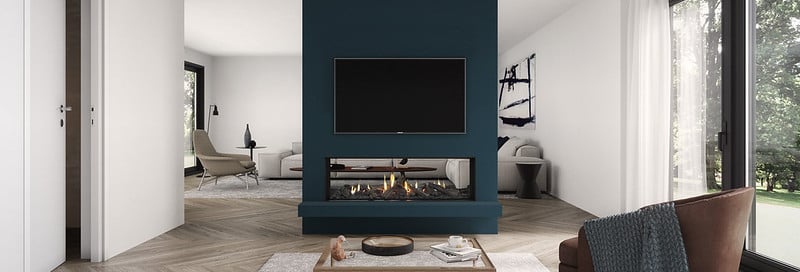Frequently Asked Questions
You can also browse the topics below to find what you are looking for.
You can also browse the topics below to find what you are looking for.

Gas fireplaces that are glass fronted are the safest option. Glass fronted design means that the room air and the combusted air do not mix. They are completely air-tight to the room, and any exhaust and fumes do not enter the home.
Learn more about glass fronted vs open fronted gas fireplaces here.
It’s also extremely important that a registered gas fitter installs your new gas fire. Gas fitters are trained for their role and they take full responsibility for the installation process. Once the fire is successfully installed and it meets all industry safety requirements, they will issue the homeowner with a code of compliance certificate. It is also recommended that the fire is serviced by a registered gas fitter or plumber every year.
Learn more about the NZ Gas Code here, or in Australia, check with your local government authority.
Escea also takes the following safety measures:
The main difference is efficiency.
Open fronted gas fires use the room air to burn which makes them less efficient.
Sealed, glass fronted gas fires don’t need any air from your home – they draw air from outside the house in one flue, and expel the combusted air outside through another flue. Less energy is wasted and there’s no risk of any gas smell or exhaust in the home.
There are many different kinds on the market, the biggest difference between the inefficient and the highly efficient gas fires is the way they are flued and how they bring in (and take out) the air used for combustion.
This is known as a Direct Vent system and it can make a fire up to 95% efficient – compared to an open fronted fireplace at around 45%.
Learn more about glass-fronted fireplace efficiency here.
Escea has a wide range of indoor gas fireplaces, single and double sided, all of which are glass fronted sealed units.
Escea gas fires can be installed three different ways – freestanding, insert and inbuilt.
Freestanding fires work well when space is limited, and are easy to install. Insert fires (or retrofittable gas fires) are great for homes that already have an existing fire you want to replace (and keeps the cost down if you’re using the same surround). Inbuilt gas fireplaces require you to build a surround around the fire, creating an enclosure for the wall fireplace and flue. Inbuilt gas fireplaces can be single or double sided.
It depends if the gas fire is open fronted or glass fronted.
Open fronted gas fireplaces work in much the same way as a traditional open wood fireplace. This means the fire will use air from the room as an ignition source, and while a certain amount will be drawn under the fire and recirculated into the room, a proportion of the rooms warm air will be drawn into the fireplace box and travel out through the flue.
All Escea fireplaces are glass fronted sealed units. This means air is introduced directly into the firebox (or heat chamber) from outside and pulled down the flue. Air within the room is pulled in through the front of the fireplace surround and over a heat exchanger then circulated back via either a fan or duct system. The fumes are then exhausted back out through another flue, so there’s no potential for harmful fumes to get inside the home.
All Escea gas fires are sealed, glass fronted fireplaces because this is the only way to seal the combustion area of the fireplace.
Learn more about open fronted vs glass fronted fireplaces here.
We noticed that you are browsing our New Zealand site from within North America.
Would you like to change to North America?